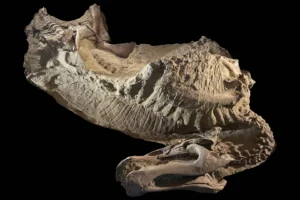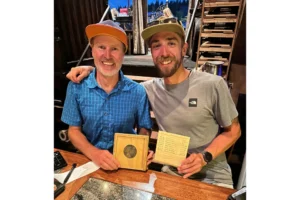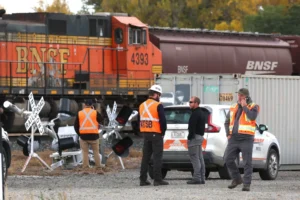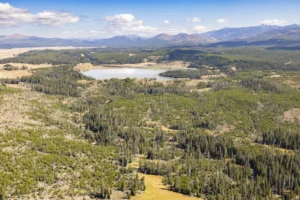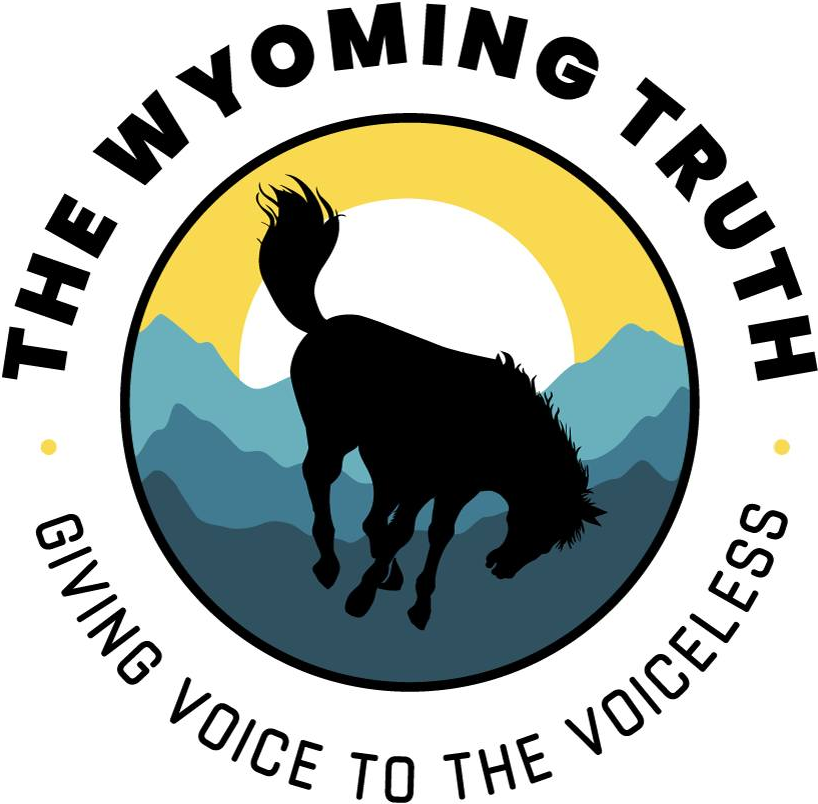14 Mustangs Adopted at Cheyenne Frontier Days Auction
The Mantle family has been ‘gentling’ mustangs for the BLM for over 25 years
- Published In: Other News & Features
- Last Updated: Jul 30, 2023

Brian Mantle tries to convince Clara, a three-year-old bay mare, to cross the crick, which, in this case, was a tarp laid down in a hole in the sand during a demonstration at Cheyenne Frontier Days. (Wyoming Truth photo by David Dudley)
By David Dudley
Special to the Wyoming Truth
This story has been updated for clarity on July 29, 2023 as of noon MT.
CHEYENNE, Wyo.—After about an hour of trying to build up the courage to step through a tarp laid in the sand, Clara, a three-year-old bay mare from Wyoming, jabbed it lightly with her front hoof. She lowered her head to see it more clearly.
Brian Mantle, 40, was in the saddle. He whispered into Clara’s ear, encouraging her to cross the makeshift “crick.” After poking the tarp with her hoof a few more times, she stepped onto it. Something about the way it moved, the way it crinkled, maybe, made her uneasy. Startled, Clara withdrew her hoof. But the tarp came with it. She jumped back, bringing the tarp with her.
“Now, she’s spooked,” said Mantle’s dad, Steve. “But don’t count Brian out. He’s my son, after all. He’s been working with horses since he was born. And he’s been working with wild horses since he was 12. He’s not about to just give up.”
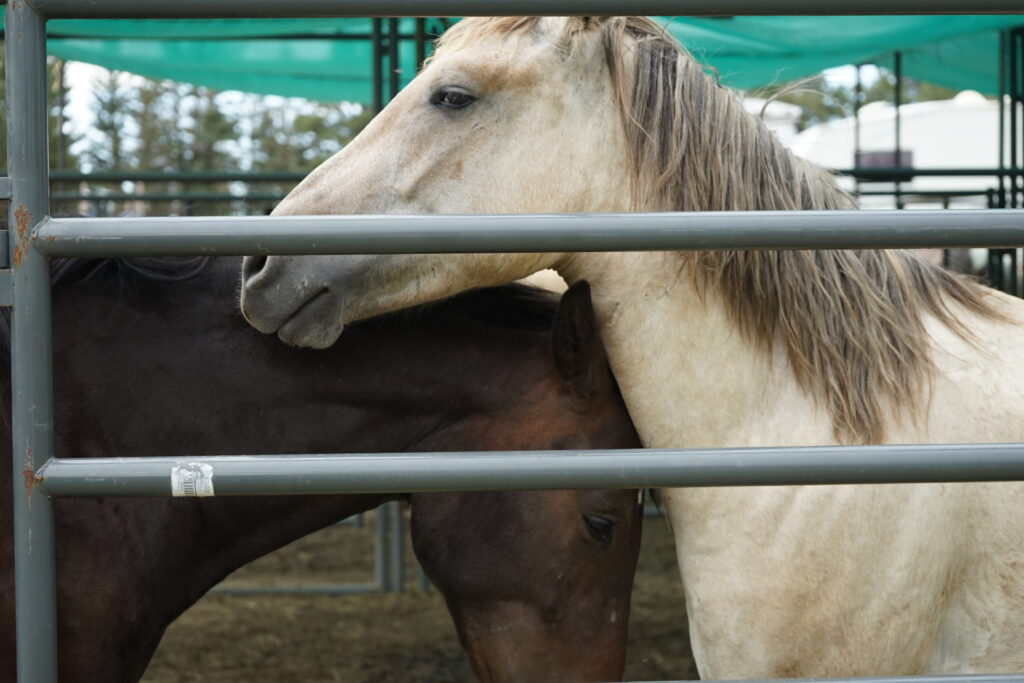
Clara trotted around the temporary round pen, lined with sand and situated on the southside of Lions Park. Mantle gave her just enough room to feel comfortable again, then he steered her toward the tarp for another go at the crick.
How to adopt a mustang
This was all part of a public demonstration at Cheyenne Frontier Days put on by the Mantle family, who have “gentled” about 1,500 mustangs for the Bureau of Land Management (BLM) during the past 25 years. The demonstration showed the 20 onlookers how to make mustangs gentle enough to keep at home, so they might adopt one.
The BLM, an agency within the U.S. Department of the Interior responsible for administering federal lands, gathers mustangs from remote areas across the Cowboy State to ensure that the horses are happy and healthy in the wild.
In Wyoming, the BLM manages nearly 5 million acres. Since 1971, the agency has removed about 37,000 mustangs and wild burros from public rangelands.
“But we can’t just go rounding up wild horses,” Molly Pittman, BLM public affairs specialist, told the Wyoming Truth. “We go through the National Environmental Policy Act process, which is meant to provide decision makers and the public with information about potential impacts — environmental, social and economic — of proposed actions.”
When food and water become scarce, for instance, the BLM may deliver those necessities to areas where the horses are known to gather. Sometimes, overpopulation becomes a problem, as the horses are sturdy animals that have no natural predators within their range.

“Their population can double every few years,” Pittman said.
When this happens, food and water supplies can become stressed. In an attempt to protect the horses and burros, as well as their rangeland, the BLM rounds them up for adoption.
Requirements to adopt include an application, a baseline fee of $125 and a facility with access to feed, water and shelter. In addition to Cheyenne Frontier Days, interested parties may attend adoption events in Rock Springs, Lander and Wheatland, among other Wyoming towns. The BLM also offers adoption events in other states and through an online corral.
Applicants must be 18 years or older and have no convictions of inhumane treatment of animals or violation of the Wild Free-Roaming Horses and Burros Act of 1971, which was designed to protect the animals.
“We want people to see that they can adopt a mustang from the range and build a lifelong bond with them,” Pittman said.
The current iteration of the event has been part of Cheyenne Frontier Days since 2015, during which time there’s been a 100% adoption rate for somewhere between 15 and 20 horses each year, according to Steve. By Friday evening, all 14 of this year’s mustangs had been adopted.
Gentler is better
The Mantles, who live and work in Wheatland, are five generations deep in gentling wild horses. Steve, 66, and his team spend between eight days and eight weeks with each one, showing it how to be gentle enough to “catch, lead and load.”
He’s contracted with the BLM for 25 years, since he went to Colorado to adopt two mustang colts in 1998. During that visit, a BLM representative approached Steve about preparing mustangs for adoption, and he agreed.
When asked how he does it, Steve’s wry sense of humor shines through.
“Well, horses are inherently lazy,” he said. “That’s why we get along so well.”
When asked to elaborate, Steve said that he makes it hard for them to do the things he doesn’t want them to do.
“And I make it easy for them to do the things I want them to do,” he added. “If that sounds simple, it’s because it is.”

That’s not to say it’s easy. Gentling horses requires lots of ground work and patience. One must be calm and quiet, and learn to read the animal’s body language. The horse, Stave said, does the same thing to people.
To take one example, when Steve watched Clara trot around the corral to avoid the “crick,” he began thinking aloud.
“First thing is, if the horse is afraid, you’re not going to make it less afraid by being rough with it,” he said. “If what you’re doing isn’t good for the horse, it’s not good for you. So, losing your temper will set you and the horse back.”
Giant steps
The younger Mantle hadn’t lost his temper. In fact, he seemed indifferent toward Clara’s stubbornness. How to convince Clara to cross the “crick?”
“You’ve got to apply pressure when she tries to get away from it,” Steve said. “And you’ve got to let her rest when she’s close to it, so she can warm up to the idea on her own. You’ve got to convince her that crossing the crick is the best thing to do in this situation.”
As Steve said that, Mantle and Clara sidled up to the crick again. The audience, who had been chattering amongst themselves before, fell silent.
“Tchk, tchk, tchk,” Mantle whispered to Clara. “Tchk, tchk, tchk.”
Clara stood above the tarp, looking down.
“She’s going to do it,” said Steve. “You can tell that he’s relaxed her, because her neckline is straight, aligned with her back.”
Clara bowed her head and poked the tarp again with her right hoof. After careful consideration, she walked across the crick.
Steve beamed as the crowd showered his son and Clara with applause.

